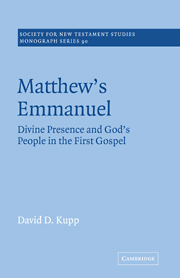Book contents
- Frontmatter
- Contents
- Preface
- List of abbreviations
- 1 Introduction
- 2 Matthew's narrative art
- 3 Reading Matthew's story of divine presence
- 4 Paradigms of presence in the Old Testament
- 5 ‘I am with you’: the Old Testament tradition of the saying
- 6 Matthew 1: the birth of the ‘God-with-us’ Messiah
- 7 Matthew 18.1–20: the presence of Jesus and his έκκλησία
- 8 Matthew 28.16–20: the presence of the risen Jesus
- 9 Jesus' presence and Matthew's christology
- 10 Conclusion
- Bibliography
- Index of passages
- Index of authors
3 - Reading Matthew's story of divine presence
Published online by Cambridge University Press: 19 January 2010
- Frontmatter
- Contents
- Preface
- List of abbreviations
- 1 Introduction
- 2 Matthew's narrative art
- 3 Reading Matthew's story of divine presence
- 4 Paradigms of presence in the Old Testament
- 5 ‘I am with you’: the Old Testament tradition of the saying
- 6 Matthew 1: the birth of the ‘God-with-us’ Messiah
- 7 Matthew 18.1–20: the presence of Jesus and his έκκλησία
- 8 Matthew 28.16–20: the presence of the risen Jesus
- 9 Jesus' presence and Matthew's christology
- 10 Conclusion
- Bibliography
- Index of passages
- Index of authors
Summary
The adoption of the narrative-critical paradigm requires a change in reading strategy. For narrative critics, the centre of authority shifts from the author or text towards the reader, in recognition that the reader participates with the story-teller and tale in producing meaning from the narrative world. The following reading adheres to the sequential flow of Matthew's narrative, and focuses on plot elements like anticipation–fulfilment and acceptance–rejection. The limitations of this study have precluded the luxury of a sustained, moment-by-moment story of reading which incorporates the many details of the narrative. The agenda here is to highlight those significant features which illuminate Matthew's presence motif.
This study is concerned less with a reader-response analysis than with story and rhetoric. In so far as the reader's experience is integral to the construction of the story world and meaning, reference will be made to the implied reader's participation and responses. I am assuming that, in Iser's words, the implied reader
incorporates both the prestructuring of the potential meaning by the text, and the reader's actualization of this potential through the reading process.
Or, as Howell words it, the implied reader is ‘both textual structure to be realized and structured act of realization’. In other words, the implied reader as textual structure already inhabits the narrative text as the audience which ‘embodies all the predispositions necessary for the literary work to exercise its effect’.
- Type
- Chapter
- Information
- Matthew's EmmanuelDivine Presence and God's People in the First Gospel, pp. 49 - 108Publisher: Cambridge University PressPrint publication year: 1996



